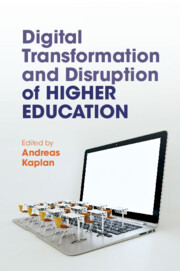Book contents
- Digital Transformation and Disruption of Higher Education
- Digital Transformation and Disruption of Higher Education
- Copyright page
- Contents
- Figures
- Tables
- Contributors
- Preface
- Chapter 1 Nothing Is Constant Except Change
- Part I (R)evolution of the Higher Education Sector
- Part II Changes in Teaching Formats
- Part III Changes in Teaching Content
- Part IV Networking and Social Activities
- Chapter 16 Working Adults’ Networking and Social Activities in Lifelong Learning
- Chapter 17 Students’ Social Networks in a Digitalised and Multicultural World
- Chapter 18 Universities’ Online Networking Operations
- Part V Certification and Diplomas
- Part VI Careers and Professionalisation
- Part VII Futuristic and Ultramodern Higher Education
- Part VIII Higher Education in Motion
- Editor’s Biography
- Index
- References
Chapter 16 - Working Adults’ Networking and Social Activities in Lifelong Learning
from Part IV - Networking and Social Activities
Published online by Cambridge University Press: 09 June 2022
- Digital Transformation and Disruption of Higher Education
- Digital Transformation and Disruption of Higher Education
- Copyright page
- Contents
- Figures
- Tables
- Contributors
- Preface
- Chapter 1 Nothing Is Constant Except Change
- Part I (R)evolution of the Higher Education Sector
- Part II Changes in Teaching Formats
- Part III Changes in Teaching Content
- Part IV Networking and Social Activities
- Chapter 16 Working Adults’ Networking and Social Activities in Lifelong Learning
- Chapter 17 Students’ Social Networks in a Digitalised and Multicultural World
- Chapter 18 Universities’ Online Networking Operations
- Part V Certification and Diplomas
- Part VI Careers and Professionalisation
- Part VII Futuristic and Ultramodern Higher Education
- Part VIII Higher Education in Motion
- Editor’s Biography
- Index
- References
Summary
This chapter explores the mechanisms and measures for implementing and evaluating the impact of networking practices in the online higher education environment. It draws on the extensive experience of a fully online Australian business school for working adults in using social networking and social activities to enhance learning, build community, impact professional advancement and create lifelong learning opportunities for alumni. This chapter also offers key insights into a pertinent question regarding the extent to which social activities should be facilitated by the institution, be self-initiated and administered by students or alumni themselves or be a hybrid of the two. Using the example of the Australian Institute of Business, we demonstrate that the latter is the most effective approach. The evidence-based best practices contributing to mutually beneficial formal and informal interactions are discussed in terms of student-centred institutional networking and engagement initiatives, networking opportunities using social media platforms, institutional benchmarking and data collection and institutional further learning activities.
Keywords
- Type
- Chapter
- Information
- Digital Transformation and Disruption of Higher Education , pp. 195 - 208Publisher: Cambridge University PressPrint publication year: 2022



